A Feasibility Analysis at Signal-Free Intersections (2403.05739v1)
Abstract: In this letter, we address the problem of improving the feasible domain of the solution of a decentralized control framework for coordinating connected and automated vehicles (CAVs) at signal-free intersections as the traffic volume increases. The framework provides the optimal trajectories of CAVs to cross the intersection safely without stop-and-go driving. However, as the traffic volume increases, the domain of the feasible trajectories decreases. We use concepts of numerical interpolation to identify appropriate polynomials that can serve as alternative trajectories of the CAVs, expanding the domain of the feasible CAV trajectories. We provide the conditions under which such polynomials exist. Finally, we demonstrate the efficacy of our approach through numerical simulations.
- J. Chow, Informed Urban transport systems: Classic and emerging mobility methods toward smart cities. Elsevier, 2018.
- J. Guanetti, Y. Kim, and F. Borrelli, “Control of connected and automated vehicles: State of the art and future challenges,” Annual reviews in control, vol. 45, pp. 18–40, 2018.
- Y. Du, M. A. Makridis, C. M. Tampère, A. Kouvelas, and W. ShangGuan, “Adaptive control with moving actuators at motorway bottlenecks with connected and automated vehicles,” Transportation research part C: emerging technologies, vol. 156, p. 104319, 2023.
- J. Rios-Torres and A. A. Malikopoulos, “Impact of partial penetrations of connected and automated vehicles on fuel consumption and traffic flow,” IEEE Transactions on Intelligent Vehicles, vol. 3, no. 4, pp. 453–462, 2018.
- N. Sarantinoudis, G. Tsinarakis, L. Doitsidis, S. Chatzichristofis, and G. Arampatzis, “A ros-based autonomous vehicle testbed for the internet of vehicles,” in 2023 19th International Conference on Distributed Computing in Smart Systems and the Internet of Things (DCOSS-IoT), pp. 726–733, IEEE, 2023.
- N. Shiwakoti, P. Stasinopoulos, and F. Fedele, “Investigating the state of connected and autonomous vehicles: A literature review,” Transportation Research Procedia, vol. 48, pp. 870–882, 2020.
- L. Xiao and F. Gao, “A comprehensive review of the development of adaptive cruise control systems,” Vehicle system dynamics, vol. 48, no. 10, pp. 1167–1192, 2010.
- F. N. Tzortzoglou, D. Theodosis, A. Dave, and A. Malikopoulos, “Performance-sensitive potential functions for efficient flow of connected and automated vehicles,” arXiv preprint arXiv:2309.01238, 2023.
- R. A. Dollar and A. Vahidi, “Efficient and collision-free anticipative cruise control in randomly mixed strings,” IEEE Transactions on Intelligent Vehicles, vol. 3, no. 4, pp. 439–452, 2018.
- D. Schrank, B. Eisele, T. Lomax, and J. Bak, “urban mobility scorecard,” texas a&m transp,” Inst., College Station, TX, USA, 2015.
- W. Xiao and C. G. Cassandras, “Decentralized optimal merging control for connected and automated vehicles with safety constraint guarantees,” Automatica, vol. 123, p. 109333, 2021.
- V.-A. Le, B. Chalaki, F. N. Tzortzoglou, and A. A. Malikopoulos, “Stochastic time-optimal trajectory planning for connected and automated vehicles in mixed-traffic merging scenarios,” arXiv preprint arXiv:2311.00126, 2023.
- A. Katriniok, “Towards learning-based control of connected and automated vehicles: Challenges and perspectives,” AI-enabled Technologies for Autonomous and Connected Vehicles, pp. 417–439, 2022.
- K. Katzilieris, E. Kampitakis, and E. I. Vlahogianni, “Dynamic lane reversal: A reinforcement learning approach,” in 2023 8th International Conference on Models and Technologies for Intelligent Transportation Systems (MT-ITS), pp. 1–6, 2023.
- R. Hult, M. Zanon, S. Gros, and P. Falcone, “Optimal coordination of automated vehicles at intersections: Theory and experiments,” IEEE Transactions on Control Systems Technology, vol. 27, no. 6, pp. 2510–2525, 2018.
- A. A. Malikopoulos, L. E. Beaver, and I. V. Chremos, “Optimal time trajectory and coordination for connected and automated vehicles,” Automatica, vol. 125, no. 109469, 2021.
- B. Chalaki and A. A. Malikopoulos, “Optimal control of connected and automated vehicles at multiple adjacent intersections,” IEEE Transactions on Control Systems Technology, vol. 30, no. 3, pp. 972–984, 2022.
- C. Sun, J. Guanetti, F. Borrelli, and S. J. Moura, “Optimal eco-driving control of connected and autonomous vehicles through signalized intersections,” IEEE Internet of Things Journal, vol. 7, no. 5, pp. 3759–3773, 2020.
- X. Meng and C. G. Cassandras, “Eco-driving of autonomous vehicles for nonstop crossing of signalized intersections,” IEEE Transactions on Automation Science and Engineering, vol. 19, no. 1, pp. 320–331, 2020.
- M. Abduljabbar, N. Meskin, and C. G. Cassandras, “Control barrier function-based lateral control of autonomous vehicle for roundabout crossing,” in 2021 IEEE International Intelligent Transportation Systems Conference (ITSC), pp. 859–864, IEEE, 2021.
- H. Bang, B. Chalaki, and A. A. Malikopoulos, “Combined Optimal Routing and Coordination of Connected and Automated Vehicles,” IEEE Control Systems Letters, vol. 6, pp. 2749–2754, 2022.
- Springer Science & Business Media, 2006.
- Z. Shen and K. Serkh, “Polynomial interpolation in the monomial basis is stable after all,” arXiv preprint arXiv:2212.10519, 2022.
- L. E. Beaver, “Lq-ocp: Energy-optimal control for lq problems,” arXiv preprint arXiv:2310.00168, 2023.
- H. Bang and A. A. Malikopoulos, “Optimal trajectory planning meets network-level routing: Integrated control framework for emerging mobility systems,” 2023 (in review, arXiv:2311.13193).
Sponsored by Paperpile, the PDF & BibTeX manager trusted by top AI labs.
Get 30 days freePaper Prompts
Sign up for free to create and run prompts on this paper using GPT-5.
Top Community Prompts
Collections
Sign up for free to add this paper to one or more collections.


